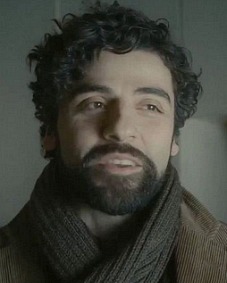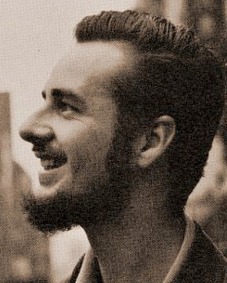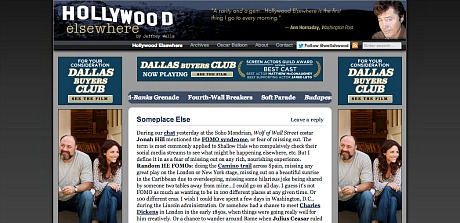The Wolf of Wall Street has me thinking about old-time druggy behavior, but not so much quaalude-driven as inspired by cannabis sativa. I’m thinking of an episode that happened while riding shotgun in a friend’s car with two others in back, and everyone thoroughly ripped. We were roaming around the wilds of Wilton, Connecticut, which is all shady (or dark) country roads and forest and shaded colonials and mock-farmhouses on two and three-acre lots. It was around 11 pm, and I can recall this like it happened last night. While engaged in a fairly mesmerizing conversation (are there any other kind when you’re fried?) the driver gradually forgot to keep his foot on the gas. The car went slower and slower until it came to a dead stop. And nobody noticed for a good five or ten minutes, of course, until some guy pulled up behind and flashed his lights and honked. If it had been a Wilton patrolman he would have have searched the car and our pockets, and somebody would have been popped for possession.
A Better Llewyn Davis Model Than Van Ronk
For nearly two years I’ve been arguing against the thesis that Oscar Isaac‘s hapless folk singer in Inside Llewyn Davis is more or less based on old-time Greenwich Village folk singer Dave Van Ronk. And yet pretty much every movie journalist on the planet has gone along with the party line, largely because director-writers Joel and Ethan Coen mentioned the connection a year or so ago and haven’t disputed it since, and also because of a folk album Van Ronk recorded called Inside Dave Van Ronk. But a much more likely real-life model — certainly a musician who bears in hindsight a much greater resemblance to Isaac’s talented but morose, going-nowhere troubadour — is the late folk singer Paul Clayton.


(l.) Oscar Isaac as the titular character in Inside Llewyn Davis; (r.) ’50s and ’60s folk singer Paul Clayton (1931 — 1967).
Lost Opportunity?
If there was ever a tweet that cried out for a YouTube complement, this is it. You can’t just boast it these days — you have to prove it. Attention spans are shorter than ever, people move on to other distractions, etc. Right now other parents are taking their musically-gifted kids to Inside Llewyn Davis, coaching them on the lyrics, rehearsing them.

Adele + Brainy Urbane Ogre
This Charlie Rose Show interview with Blue Is The Warmest Color‘s Adele Exarchopoulos is 11 days old…big deal. She was and still is my Critics Choice/BFCA pick for the 2103 Best Actress award. Will the insulated Academy farts even nominate her? Related issues: (a) How high-powered is her publicist? (b) How much schmoozing has Exarchopoulos done at industry parties? (c) How much money has Blue made? These are things that matter a great deal.
Holiday Zone-Out
The Christmas downshift begins today and won’t end until January 2nd, or 13 days from now. I can feel it in the Manhattan air. The conversation is dying down a tad. I don’t mind and in fact always enjoy the time just before Christmas, particularly in the stores and during walks around the city in the late afternoon and especially at night. But the post-Christmas blahs, a seven-day period that will begin on Thursday, 12.26, and end on Thursday, 1.2.14, are hell. Okay, they’re not “hell” but I know it always feels wonderful when they’re over. Thank God I have the amusements and distractions of New York to fiddle with. Can you imagine sinking into the post-Christmas quicksand in, say, Wilkes-Barre or Birmingham or upper New Hampshire? Do you want to feel really zoned and blah-ed out and generally trapped in your life? See Nebraska. It’s like a cherry on top of an eternally depressing ice-cream sundae. Except during those passages when Mark Orton’s score takes over. Then everything is okay.

Year’s Best Edited Films?
“The editing style is really, again, about simplicity and not gimmicks, you know? So it’s a little hard for us right now with the modern style of blender editing, where everything is two frames long. [Marty] keeps saying, ‘Where is the shot?’ Whatever happened to the great shot like Kubrick used to do? And you could watch it for six minutes and never get bored because it was so beautifully framed. It had such beautiful music. And what was going on inside was so great. Now it’s just, the image doesn’t mean anything. And they seem to be getting so short now that I wonder if they’re going to come to the end of the road. I don’t think they can make each cut any shorter! I wonder if there will be a big backlash and everything will go back to being slow again.” — Wolf of Wall Street editor Thelma Schoonmaker speaking to Hitfix‘s Kris Tapley in a 12.20 interview piece.
I always have a hard time deciding which films are exceptionally well cut. If I like a film I like the editing — it doesn’t go much deeper than that. First-rate editing — smart, fleeting, sleight of handish — is invisible, for the most part. If you don’t notice it it’s probably good. What I notice is economy and timing and, at times, the musicality. Good editing and good music share certain qualities. I sometimes notice how long a shot is held, the precise millisecond when a shot cuts to another. I also notice editing with uneven rhythms and jarring tempos, and I definitely notice cutting that seems overly frenzied and chaotic. I know that the editing in Inside Llewyn Davis seems extra-attuned. I love Thelma’s cutting of The Wolf of Wall Street, needless to say. 12 Years A Slave, for sure. Her is perfectly cut.
Are there any films that have stood out as especially well-edited for the HE community?
Someplace Else
During our chat yesterday at the Soho Mondrian, Wolf of Wall Street costar Jonah Hill mentioned the FOMO syndrome, or fear of missing out. The term is most commonly applied to Shallow Hals who compulsively check their social media streams to see what might be happening elsewhere, etc. But I define it in as a fear of missing out on any rich, nourishing experience. Random HE FOMOs: doing the Camino trail across Spain, missing any great play on the London or New York stage, missing out on a beautiful sunrise in the Caribbean due to oversleeping, missing some hilarious joke being shared by someone two tables away from mine…I could go on all day. I guess it’s not FOMO as much as wanting to be in 100 different places at any given time. Or 100 different eras. I wish I could have spent a few days in Washington, D.C., during the Lincoln administration. Or somehow had a chance to meet Charles Dickens in London in the early 1850s, when things were going really well for him creatively. Or a chance to wander around Rome when Julius Ceasar ruled the world. Or Jerusalem during the time of Yeshua of Nazareth.
Big Finish
Four nights ago August: Osage County‘s Meryl Streep, Margo Martindale and Abigail Breslin dropped by for a post-screening q & a at Pete Hammond‘s KCET film series in North Hollywood. It was the final screening of the ’13 series. There’s a sameness to on-stage, post-screening interviews. You can’t step too far outside of the routine. But there’s always something refreshing and even calming about Streep’s manner of sharing. She always seems to be reaching deep inside for something semi-spontaneous. And she’s never given a rote performance, of course. August: Osage County opens in NY & LA on 12.27.
The Hill
I sat down with Wolf of Wall Street costar Jonah Hill at the Soho Mondrian between 4:10 and 5:25 pm. We covered almost everything. I recorded it all. I’ll type up most of it and tap something out tomorrow. Hill’s portrayal of Donnie Azoff, partner in stock-fraud crime and quaalude comrade of Jordan Belfort (Leonardo DiCaprio), will live forever in the annals of motion-picture bacchanalia. Which is one way of saying it’s a superb performance. Oh, and by the way: today is Jonah’s 30th birthday. Go to the 32-minute mark for Hill’s interview on the 12.19 Charlie Rose Show.
Howl, or Best Foreign Pic Shortlist
I haven’t seen the majority of the nine films on the Academy’s just-announced Best Foreign Language Feature shortlist, but I know for a dead cold fact that Asghar Farhadi‘s masterful The Past, which didn’t make the cut, is a much, much better film than Thomas Vinterberg‘s The Hunt, which did make it…much.
Wong Kar Wai‘s The Grandmaster, which no one who knows anything has done cartwheels or backflips over, made the list but Haifaa Al-Mansour‘s widely praised Wadjda, the Saudi Arabian entry, didn’t? Indiewire‘s Eric Kohn must have punched the refrigerator door at least once.
Obviously a dark day for Sony Pictures Classics, the U.S. distributor of Wadjda and The Past. Life isn’t unfair — it’s infuriating.
Concrete Under Your Feet
I landed at Kennedy around 10 pm last night. 45 minutes (!) for the bags to finally appear on the carousel. Gypsy cab into Manhattan for $60 bills, and the guy avoided the LIE (or one of the highways heading into town) to avoid paying the toll. Awoke at 9 am or 6 am L.A. time. A Jonah Hill chat is set to happen downtown around 4 pm. Nothing wrong with a little relaxation from time to time. I have to get in touch with Glenn Kenny to…actually, maybe I should hold back on paying him that $50 I bet on American Hustle winning the Best Picture Oscar. It might just make it. The Movie Godz are foursquare against Gravity winning, I can tell you that. A Best Picture winner has to have some kind of social, political or psychological undercurrent — it has to say or reflect something about who we are (or who we used to be or want to be). Gravity says absolutely nothing except that we all want to survive — big deal.






